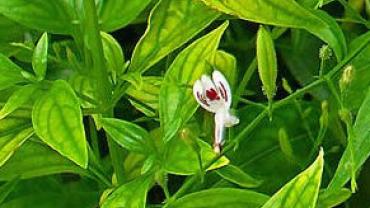
Andrographis paniculata. Sound like something dark and foreboding out of a post-apocalyptic sci-fi movie but in fact it’s a plant whose roots and leaves have been used in traditional Ayurvedic and Unani medicine to treat a variety of conditions. Like many other plants that are recognized as having medicinal properties the efficacy of andrographis may be due to compounds that impart a bitter flavor. In fact in northeastern India this plant is called Maha-tikta which means “king of bitters.” As an Ayurvedic herb it goes by the name Kalmegh or Kalamegha which translates to “dark cloud.” Perhaps the most illustrative moniker andrographis goes by is its Malaysian name Hempedu Bumi or “bile of earth.” It doesn’t get much more bitter than that!
Andrographis is native to India and other parts of south and southeast Asia. The whole plant can be employed for medicinal purposes but the roots and leaves are the parts typically used. Considering its bitterness—and its association with bile if only in name—it’s not entirely surprising that this plant may be hepatoprotective and hepatostimulant. Studies in rats have shown that extracts from andrographis have a dose-dependent choleretic effect and that prophylactic treatment with andrographolide prevented a paracetamol-induced decrease in the volume and contents of bile more powerfully than silymarin (milk thistle) a widely recognized hepatoprotective herb. Similar findings were demonstrated for protecting the liver against ethanol-induced damage in mice.
The potential for andrographis to be beneficial for liver function should be weighed against its effects on enzymes of the cytochrome P450 system. The andrographolide component of this plant significantly induced mRNA expression of CYP1A1 and CYP1A2 in cultured mouse hepatocytes and had a synergistic effect with CYP1A inducers. Andrographis extract has been reported to inhibit CYP3A4 and CYP2C9 in human liver cells.
A systematic review of randomized controlled trials (RCTs) concluded that andrographis is more effective than placebo for ameliorating the symptoms of uncomplicated upper respiratory tract infections (URTIs). URTIs are one area in which the research on andrographis has been relatively extensive and significant benefits have been found including the possibility for a preventive effect. Treatment with andrographis may also play a role in defending against the common cold. Among schoolchildren who took a dried andrographis extract for three months during winter the incidence of the common cold was significantly lower than among those who received the placebo. (Incidence was 30% [16/54] among the andrographis group compared to 62% [33/53] among the placebo group. No difference was noted after just one month though suggesting that the preventive effect may take time.) Andrographis extract has been used in Scandinavia for ameliorating subjective symptoms of sinusitis and the common cold as well as for shortening the duration of symptoms. Studies in mice have shown andrographis extracts to stimulate both antibody-mediated and non-specific immune activity which may underlie its effects. For this reason however it may be best that people with autoimmune conditions avoid andrographis.
Another contraindication for this otherwise potentially helpful plant is for individuals who take blood thinning medication as andrographis may increase the risk of bleeding in this patient population. Andrographis may also interact with medication for high blood pressure as it has ACE-inhibitory effects and extracts have been shown to reduce blood pressure in spontaneously hypertensive rats. This plant may be beneficial in other populations as it has antithrombotic activity and may inhibit platelet aggregation.
Andrographis is contraindicated for men and women attempting to conceive a child and for women during pregnancy. Studies in animals are mixed and inconclusive but the weight of the evidence suggests that andrographis may have anti-fertility effects and may induce abortion likely due to interactions with progesterone and progesterone-dependent processes. In male rats andrographis was shown to adversely affect sperm quantity and induce structural changes to the seminiferous tubules Leydig cells epididymis and seminal vesicles.